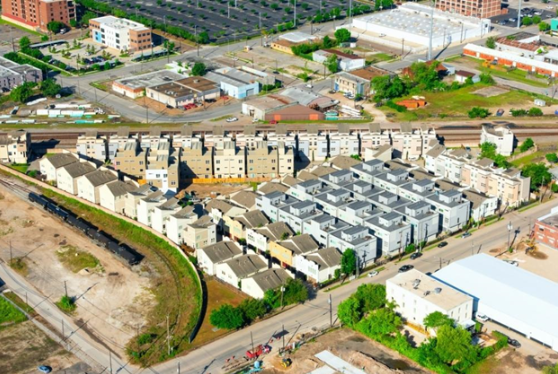How Zoning Can Support Affordable Housing

How Zoning Can Support Affordable Housing
By Jerome Ryans, President & CEO, Tampa Housing Authority
In conversations revolving around affordable housing, we often end with the same refrain: "What do we do about it?" While it would feel satisfying to enact broad, sweeping changes all at once, the realistic solutions-and the challenges-often lie in the details that are right in front of us. Zoning falls into this category and can be a small but mighty tool in the pocket of Public Housing Agencies (PHAs) and affordable housing advocates.
What kinds of zoning help bring home rental and home ownership within reach for the lower-income people in a city? Not surprisingly, the usage of zoning for this goal is complex, with pros and cons to consider - as well as stigmas to counter.
Zoning Measures that Can Be Taken
In the simplest terms, some zoning measures have been found to generally help increase housing stock and, therefore, lower prices. Many of these measures can be summed up under the term "inclusionary zoning." This term arose in response to historically exclusionary zoning, which kept people of particular ethnic and socioeconomic groups sidelined in terms of where they could live and work.
Minimum-Density
This requirement in zoning pushes for the most efficient use of space. For example, a minimum-density zoning ordinance could require a half-acre parcel of land to contain at least 10 housing units.
In some areas, it could be tempting for buyers to purchase a half-acre and build one single-family home on it, leaving lots of space around the house. While this is appropriate for some regions, like rural areas in which space is not a problem, an insistence on single-family homes in dense, urban spaces can create a real backlog of available housing and drive up prices.
It also encourages urban sprawl, which is often tied to longer commutes, translating to higher transportation costs. Minimum-density zoning encourages tides to go in the opposite direction.
More Flexible Zoning
In some cases, a minimum-density requirement proves too extreme based on the housing already present and the attitudes of current residents and developers. How can more housing density still be encouraged? A response is with zoning categories that offer more flexible arrangements.
This could look like mixed residential/commercial zoning, allowing multi-family zoning without requiring it, or easing zoning restrictions so that single-family homeowners can add accessory dwelling units (ADUs) like backhouses, tiny houses, or so called mother-in-law suites. Even small changes in density make a difference for folks who are searching for a stable home.
Reevaluate Parking Requirements & Increase Public Transit
Parking requirements are a particular sticky point in some zoning standards. In the South, building density has often been blocked because of outdated parking standards in zoning.
For instance, Texas buildings must allot one parking spot in a building's plan in correspondence with its occupancy; that is, if a building can fit 200 people, it needs to be connected to a parking lot with 200 spots.
Even if you are a fan of ample parking, you can probably see how this is unrealistic. If a family of five drives to a grocery store, it's reasonable to assume that they would travel in one or maybe two cars - it's rare that five related people would need to drive separately to the same location.
It also does not recognize or prioritize public transit infrastructure. In denser areas, like a walkable downtown, it might behoove cities to relax parking requirements to facilitate denser housing and mixed-use buildings.
Rezoning Underused Areas to Reflect the Present
One of the largest ways that those who create zoning can support stable housing is by realistically updating zoning to respond to the community's needs of the present.
Many zoning ordinances that served past intentions fall out of attention and gather dust, locking up land and buildings that could be put to good use now. You can see this in the transformation of American cities from centers of manufacturing to centers of "softer" jobs in the white-collar sphere.
Large swaths of city land that were once zoned from factories do not need to be set aside for this purpose anymore. Many cities would be wise to rezone these industrial areas to suit residential or mixed residential/commercial needs.
Imagine the acreage that could be gained and the density that could spring up - not to mention, there is a history of artists turning more affordable industrial areas into thriving cultural hubs, which drives up property value in the long run.
Another way to respond to needs of the present is to rework zoning designations that are overly broad - for example, some codes prohibit the building of housing units that "change the character of a neighborhood."
Encourage your commissioners to ask: What does this mean? What defines the character of a neighborhood, and what kind of building would truly change it? Would an apartment building in the same historic style as the surrounding house actually change the "character" of a neighborhood?
While some may argue that this aspect of zoning helps preserve communities, historically, statutes that are too open to interpretation have also been used to discriminate. The solution is not to do away with preservation efforts - it is simply to make these zoning recommendations far more specific.
If the character of a neighborhood is defined by "1920s art deco style buildings," that does not limit the density or the demographic makeup of residents in an area. It simply dictates that developers need to build units with a certain architectural style.
It is most important to survey, observe, and assess your community's present needs to determine what kind of zoning would serve it. Take care to question current zoning and not hold anything as sacrosanct: "Why is this zoning in place? Who does it serve?"
Pushback Against Changing Zoning
You would think that, if these solutions are so forthcoming, they would already be implemented in cities nationwide. Yet, they are not.
Why is the process to change zoning sometimes an uphill battle? There are several reasons.
Property Value Worries
One common myth that circulates among homeowners: multi-family and mixed zoning bring down property values. A home is a big investment, and it makes sense to monitor the things that affect one's property value, but is there any reality to this concern?
In general, the data says "No" - single-family property values will, at minimum, remain the same. Some studies have even shown that denser housing actually helps raise property values. The reasoning may be that denser and mixed zoning allow for more walkable areas with public transit services and small businesses - factors which often create a more pleasant neighborhood experience.
Concerns About School Districts
Owners of single-family homes frequently have children. Accordingly, they may voice concerns about their school districts being overly flooded with new students if multi-family housing units are allowed to be constructed in their neighborhood. Once again, the concern of a suddenly overburdened school is legitimate - but is that likely to happen?
Demographics play a big role in how this actually plays out. Let's think for a second: when you imagine a "typical" apartment dweller, who do you imagine? While some families come to mind, I bet you also envisioned a young, single professional, a retired couple, or a single elderly person.
That's because apartments generally appeal to these populations more than families with children - which means that it's unreasonable to assume that, for every new apartment, 1-3 children will be added to the school district. A less numerous - and more manageable - influx of new students is far more likely.
Stereotypes re: Crime and Apartments
As we mentioned in our public housing myths blog post, apartments - especially those with below-market-rate units - often carry the stigma of being hotbeds for crime. Is there truth to this?
While some public housing apartments historically were built in areas that already had high crime rates, generally: no, apartments do not result in more crime to an area. A University of Arkansas report confirmed this. With modern surveillance capabilities like door cams, we are more protected from property and violent crime than ever - regardless of whether you live in a house or an apartment.
Resistance to Change
Another obstacle is the plain fact of bureaucracy. It takes time to rewrite zoning ordinances, hold meetings, collect comments, and vote on changes.
Some of this slowness is necessary in order to avoid statute whiplash, in which a legal landscape changes so quickly that people and businesses freeze, afraid they may violate a new law without knowing. However, sometimes unnecessary bureaucratic practices can cause a backlog of changes with widespread support that simply need to be implemented.
Working with your local government officials by attending public meetings, writing or emailing letters, and phoning offices can help keep priorities clear in the face of many competing backlogs.
Zoning for the Needs of the Present
The bottom line is that, in many areas, the current zoning regulations in place do not reflect the needs of the population. Single family homes will always cost more money and take up more space, and those are two things that are not always in ready supply. It isn't about doing away with the single family home, though - it's about providing options for a wide variety of people who may be at different places in their lives.
Making changes to zoning laws is one way to jumpstart that effort, and it's something that every area needs to take a long, hard look at to see how to best serve the current - and future - needs of their citizens.
References
National Association of Home Builders. (2008). "Changes in Zoning to Encourage Affordable Housing." Retrieved from [URL]: https://www.nahb.org/-/media/NAHB/advocacy/docs/top-priorities/housing-affordability/overview-allow-a-range-of-housing-types.pdf
United States Census Bureau. (2019). "American Housing Survey." Retrieved from [URL]: https://www.census.gov/programs-surveys/ahs/about.html
University of Arkansas (2017). "Effects of Multi-Family Housing on Property Values, Crime and Code Violations in Little Rock, 2000-2016." Retrieved from [URL]: https://ualr.edu/publicaffairs/files/2016/06/lr_multifamily_report_final.pdf



